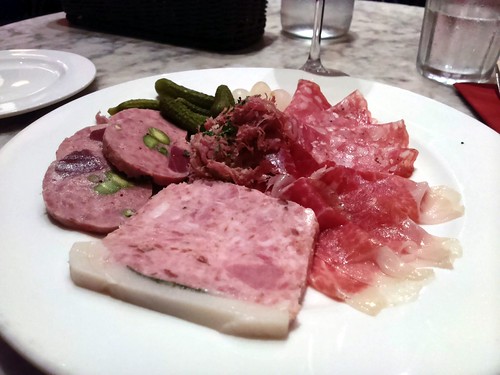 |
| St. Declan's Oratory |
 |
| One of the Ogham Stones at Ardmore |
The cathedral was extensively modified in the seventeenth century, when large buttresses were added and the chancel was enlarged.
The wonderful series of early medieval sculpture set within Romanesque arcading pictured below can be seen on the western gable end of the Cathedral. The series of panels with sculpture is an unusual feature. The style of artwork and the Romanesque arcading certainly suggest it is from the time of the bishopric in around 12–13th Century, but its position probably dates to the early 17th Century, when Ardmore underwent a series of renovations and alterations. The sculptures are very worn today, and are quite difficult to make out. The larger panels underneath are a little clearer and show [from left to right], a figure on a horse, Adam and Eve, then it looks like two kneeling figures. On the second panel to the right, I believe the lower figures show the adoration of the Magi, and above them is a sculpture depicting the Judgement of Solomon. The carvings depicted in the arcading along the top are far more difficult to make out unfortunately.
The Round Tower is one of the most striking examples in Ireland. It is a little later than most, as it is believed to be twelfth century. It tapers to a height of 30m and has a doorway positioned about 4m off ground level.
The Round Tower is also unusual in the three distinct external rings, after each the wall is inset a little which adds to the dramatic tapering effect. Scholars have long pondered about the function of round towers. The debate reached a pinnacle in the mid 19th century.
One commentator suggested that they were built by the Tuatha de Dannan, a mythical tribe of warriors who were said to have invaded Ireland and eventually they transformed into otherworldly fairy figures. Another scholar suggested that the towers were built by the Danes or Vikings to look out and monitor the movements of the native Irish. The most common story about round towers was that they were built not by the Vikings but by the Irish monks as a look out and defensive feature against Viking raids. It was thought that during times of attack, the Irish monks would collect the valuables of the monastery, run to the round tower, climb up to the doorway via a rope ladder, pull this up after the last monk ascended, close the large wooden door and be safe from Viking attack. Unfortunately, this would not have been the case. The round towers would not have made a good refuge during Viking raids. Once inside the tower the fleeing populace would find themselves trapped, with no water or sanitary facilities and the wooden floors and ladders would have been susceptible to fire. Instead it is more plausible that the Round Towers were constructed as bell towers. Indeed they are known as ‘cloigh teach’ in Irish Gaelic which translates to ‘bell house’. They would have also been visible from miles around, and as such they would have acted like a signpost to weary pilgrims on the route to Ardmore.
With its beautiful setting and number of interesting medieval buildings and features Ardmore should be on your must-see list if you are in Munster. If you visit on a sunny day there are few sites to compare with it in Ireland.
To get there simply head into the village of Ardmore in County Waterford and follow the signs up the hill, it is very easy to find.
I hope you enjoy this blog, we're trying to cover as many sites as we can across Ireland. If anyone has any suggestions about sites you'd like us to cover please do leave us a comment. If you enjoy information and images of Irish heritage sites then do follow us on Facebook, Twitter and Google+ If you'd like to support us then please consider downloading an audioguide to one of Ireland's wonderful heritage sites. They are packed with original music and sound effects and are a great way of experiencing the story of Ireland. They only cost €1.99 and are fun whether you are at the site, or listening from the comfort of your own home. If you enjoy stories of the turbulent medieval period in Ireland try our guide to Viking and Medieval Dublin, visit us at www.abartaaudioguides.com for free previews and to download your free audioguide to the Rock of Dunamase or the free audioguide to the wonderful heritage town of Kells in County Meath
All photographs © Neil Jackman / abartaaudioguides.com














































